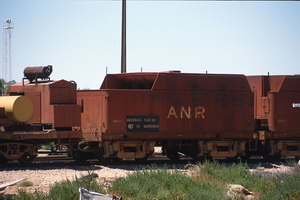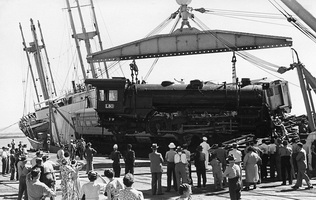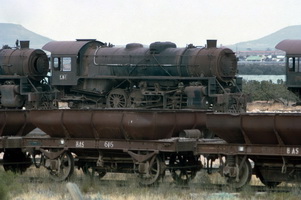
Jump to:
| L 80 | L 81 | L 82 | L 83 | L 84 | L 85 | L 86 | L 87 | L 88 | L 89 |
The Commonwealth Government agreed to assist the United Nations Relief and Rehabilitation Administration (U.N.R.R.A.) by building 50 locomotives for service in China based on the South Australian Railways 700 class. Shortly after awarding the contract to Clyde Engineering, N.S.W., and construction had commenced, political options forced the abandoning the proposal. The communist party had come into power in China and public opinion was now against any form of contact with the new regime. In an attempt to fulfil its obligations to Clyde, the Department of Supply offered to sell the locomotives to the various Australian rail systems. Eventually the South Australian and the Commonwealth Railways agreed to take 10 locomotives each, with the remaining 30 being cancelled.
The South Australian Railways used 700 class locomotives as a heavy freight hauler on secondary lines, having introduced them as part of the South Australian Railways Commissioner's W.A.Webb's upgrading program in 1926. South Australian Railways's Chief Mechanical Engineer, Mr F. Shea, who was also responsible for the construction of the large 500 and 600 class locomotives, had 10 of the class built to his design. At the time, all three class of locomotives were considered large by Australian standards and set a new benchmark for both performance and economy of operation. This lead to the 700 class design being submitted to the Chinese, who selected in preference to an alternate offering of the New South Wales Government Railways C38 class.

In Australian a locomotive with a 2-8-2 wheel arrangement is traditionally known as a Mikado type, but during and shortly after the war an attempt was made to rename 2-8-2 wheel arrangement locomotives MacArthurs, as a tribute to the American General. This lead to the Commonwealth Railways referring to the Clyde built locomotives as MacArthurs throughout their short working life.
As the locomotives had been built to the Chinese gauge of 4 ft 8½.in, they required few modifications to meet Commonwealth Railways requirements. Other than altering gauges from the metric to the imperial system, and the provision of labels in English they appear to have been left as constructed for Chinese service. Initial design work had covered most of the South Australian Railways's modifications made to the 700 class, so features such as a rolled steel funnel and an enlarged sand dome were included, resulting in a locomotive whose appearance differed little from its prototype. Additional enhancements not seen in the 700 class were the Alco reversing gear, and a steam pipe at the rear of the tender for connection to steam heated carriages.
Post-war reconstruction on the Commonwealth Railways recognised the need for additional locomotive power, but favoured the introduction of diesel-electric over steam. They had tried unsuccessfully during the war to obtain diesel locomotives and again around 1946-47. Chronic water problems on the Trans-Australian line combined with poor quality coal meant that steam was a costly liability that should be done away with a soon as funds permitted. With the introduction of a proposal for a new standard gauge line between Port Augusta and Telford (Leigh Creek), to transport coal, it became urgent to find additional motive power to supplement the existing locomotive roster. It was thought the L class units would be an ideal solution until Government monetary policy allowed for the purchase of diesel units, something that was not expected to happen in the short term.
After confirming the purchase of the L class units, the Commonwealth Government suddenly altered its monetary policy by making funds available to the Commonwealth Railways for dieselisation. This lead to Clyde Engineering also being awarded the contract for manufacture of the Commonwealth Railways first mainline diesel-electric locomotives, which would called the "GM" class. As there were delays in obtaining approval for the construction of the Telford line and at that stage, the Commonwealth Railways was not short of motive power, preference was given to the completion and delivery of the South Australian Railways MacArthurs.
All ten L class engines were forwarded to Port Augusta by sea, but delays as a result of the completion of the South Australian engines, post war shortages of materials, and industrial unrest caused more than two years to elapse between the delivery of the first and last locomotives. L 80 and L 81 were delivered to Port Augusta in March 1951 and placed in service on the eastern end of the Trans-Australian Railway. By the time the other engines were delivered the GM diesel-electric's had already entered service, making the remaining L class surplus. Despite L class locomotives hauling some construction trains on the standard gauge line from Stirling North to Marree during the early 1950s, many of the units never entered service, instead going directly to the scrap line at Port Augusta.

In 1960, well after most other steam locomotives had been scrapped, an initial tender for disposal was called. All ten engines, minus their tenders, were by that time on the scrap line. By 1964 only "L 87" had actually been disposed of, so tenders were again call. This resulted in the remaining units being sold over the next few years, with only the locomotive tenders being retained for use as water tanks on weed poisoning train.
| Class: | L | |
| Builder: | Clyde Engineering | |
| Introduced: | 1951 | |
| Number in Class: | 10 | |
| Wheel Arrangement: | 2-8-2 | |
| Driving Wheel Diameter: | 4 ft. 9 in. | |
| Cylinders: | Number: | 2 |
| - | Position on frame: | Outside |
| - | Diameter x stroke: | 22 in. x 28 in. |
| Valve Gear: | Walschaert | |
| Heating Surface: | Tubes & flues: | 2,400 square feet |
| - | Superheater: | 619 square feet |
| - | Firebox: | 195 square feet |
| - | Grate Area: | 47 square feet |
| Boiler Pressure: | 200 lbs p.s.i. | |
| Tractive Effort: | 40,400 lb. | |
| Coal Capacity: | 10 tons | |
| Water Capacity: | 6600 gallons | |
| Weight in Working Order: | 169 tons 4 cwt. | |
| Maximum Axle Load: | 18 tons | |
| Overall Length | 73 ft. 1 in. | |

Steam locomotive with 2-8-2 wheel arrangement, built by Clyde Engineering.
| 15.3.1951 | Delivered to Port Augusta. Built by Clyde Engineering, builders No.514. |
| 4.1951 | Officially in service. |
| 1955 | Fitted with "C" class tender. |


Steam locomotive with 2-8-2 wheel arrangement, built by Clyde Engineering.
| 15.3.1951 | Delivered to Port Augusta. Built by Clyde Engineering, builders No.. |
| 4.1951 | Officially in service. |
| 1955 | Fitted with "C" class tender. |
Steam locomotive with 2-8-2 wheel arrangement, built by Clyde Engineering.
| 9.4.1952 | Delivered to Port Augusta. Built by Clyde Engineering, builders No.. |
| 9.4.1952 | Officially in service. |
| 1967 | Scrapped. |
| 1968 | Sold to Hines Metals 1967, boiler to Kuala Lumpur. |
Steam locomotive with 2-8-2 wheel arrangement, built by Clyde Engineering.
| 9.4.1952 | Delivered to Port Augusta. Built by Clyde Engineering, builders No.517. |
| 9.4.1952 | Officially in service, but may not have ever actually been used. |
| 1965 | Scrapped. |
| 1965 | Boiler sold to New Guinea. |
Steam locomotive with 2-8-2 wheel arrangement, built by Clyde Engineering.
| 9.4.1952 | Delivered to Port Augusta. Built by Clyde Engineering, builders No.518. |
| 9.4.1952 | Officially in service, but may not have ever actually been used. |
| 1967 | Scrapped. |
| 1967 | To Hines Metals. |
Steam locomotive with 2-8-2 wheel arrangement, built by Clyde Engineering.
| 9.4.1952 | Delivered to Port Augusta. Built by Clyde Engineering, builders No.519. |
| 9.4.1952 | Officially in service, but may not have ever actually been used. |
Steam locomotive with 2-8-2 wheel arrangement, built by Clyde Engineering.
| 14.7.1952 | Delivered to Port Augusta. Built by Clyde Engineering, builders No.525. |
| 11.1952 | Officially in service, but not actually ever used. |

Steam locomotive with 2-8-2 wheel arrangement, built by Clyde Engineering.
| 14.7.1952 | Delivered to Port Augusta. Built by Clyde Engineering, builders No.526. |
| 11.1952 | Officially in service, but not actually ever used. |
| 1963 | Scrapped. |
| before 1964 | Disposed of. |